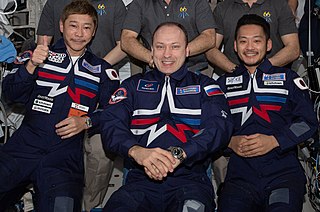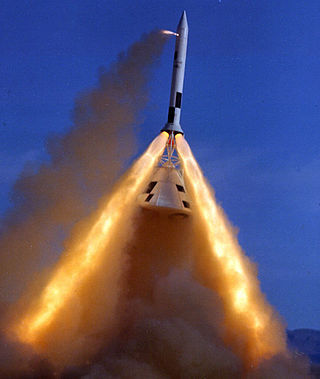
Space tourism is human space travel for recreational purposes. There are several different types of space tourism, including orbital, suborbital and lunar space tourism. Tourists are motivated by the possibility of viewing Earth from space, feeling weightlessness, experiencing extremely high speed and something unusual, and contributing to science.
Human spaceflight programs have been conducted, started, or planned by multiple countries and companies. Until the 21st century, human spaceflight programs were sponsored exclusively by governments, through either the military or civilian space agencies. With the launch of the privately funded SpaceShipOne in 2004, a new category of human spaceflight programs – commercial human spaceflight – arrived. By the end of 2022, three countries and one private company (SpaceX) had successfully launched humans to Earth orbit, and two private companies had launched humans on a suborbital trajectory.

A reusable launch vehicle has parts that can be recovered and reflown, while carrying payloads from the surface to outer space. Rocket stages are the most common launch vehicle parts aimed for reuse. Smaller parts such as rocket engines and boosters can also be reused, though reusable spacecraft may be launched on top of an expendable launch vehicle. Reusable launch vehicles do not need to make these parts for each launch, therefore reducing its launch cost significantly. However, these benefits are diminished by the cost of recovery and refurbishment.

Blue Origin Enterprises, L.P., commonly referred to as Blue Origin is an American aerospace manufacturer, defense contractor, launch service provider and space technologies company headquartered in Kent, Washington, United States. The company makes rocket engines for United Launch Alliance (ULA)'s Vulcan rocket and manufactures their own rockets, spacecraft, satellites, and heavy-lift launch vehicles. The company is the second provider of lunar lander services for NASA's Artemis program and was awarded a $3.4 billion contract. The four rocket engines the company has in production are the BE-3U, BE-3PM, BE-4 and the BE-7.

A launch escape system (LES) or launch abort system (LAS) is a crew-safety system connected to a space capsule. It is used in the event of a critical emergency to quickly separate the capsule from its launch vehicle in case of an emergency requiring the abort of the launch, such as an impending explosion. The LES is typically controlled by a combination of automatic rocket failure detection, and a manual activation for the crew commander's use. The LES may be used while the launch vehicle is on the launch pad, or during its ascent. Such systems are usually of three types:
New Shepard is a fully reusable sub-orbital launch vehicle developed for space tourism by Blue Origin. The vehicle is named after Alan Shepard, who became the first American to travel into space and the fifth person to walk on the Moon. The vehicle is capable of vertical takeoff and landings. Additionally, it is also capable of carrying humans and customer payloads into a sub-orbital trajectory.

A commercial astronaut is a person who has commanded, piloted, or served as an active crew member of a privately funded spacecraft. This is distinct from an otherwise non-government astronaut, for example Charlie Walker, who flies while representing a non-government corporation but with funding or training or both coming from government sources.

Vertical takeoff, vertical landing (VTVL) is a form of takeoff and landing for rockets. Multiple VTVL craft have flown. The most successful VTVL vehicle was the Apollo Lunar Module which delivered the first humans to the Moon. Building on the decades of development, SpaceX utilised the VTVL concept for its flagship Falcon 9 first stage, which has delivered over two hundred successful powered landings so far.

The Boeing Starliner is a class of partially reusable spacecraft designed to transport crew to the International Space Station (ISS) and other low-Earth-orbit destinations. It is manufactured by Boeing, with the Commercial Crew Program (CCP) of NASA as the anchor customer. The spacecraft consists of a reusable crew capsule and an expendable service module.

The billionaire space race is the rivalry among entrepreneurs who have entered the space industry from other industries - particularly computing. This private spaceflight race involves sending privately developed rockets and vehicles to various destinations in space, often in response to government programs or to develop the space tourism sector.

Blue Origin NS-16 was a sub-orbital spaceflight mission operated by Blue Origin which flew on 20 July 2021. The mission was the sixteenth flight of the company's New Shepard integrated launch vehicle and spacecraft, and its first crewed flight. It carried into space American billionaire and Blue Origin founder Jeff Bezos, his brother Mark, pilot and Mercury 13 member Wally Funk, and Dutch student Oliver Daemen. The flight commenced from Blue Origin's Corn Ranch sub-orbital launch site in West Texas aboard the third flight of New Shepard booster NS4 and the spacecraft RSS First Step, both having previously flown on NS-14 and NS-15 earlier in the year.
RSS First Step is a New Shepard space capsule, built and operated by American spaceflight company Blue Origin. It is the third New Shepard capsule to fly to space, and the first to fly passengers. Its first flight was the NS-14 mission, which reached an altitude of 107 km (66 mi) on 14 January 2021.

Blue Origin NS-21 was a sub-orbital spaceflight mission, operated by Blue Origin, which launched on 4 June 2022 using the New Shepard rocket. It was Blue Origin's fifth crewed flight, and twenty-first overall to reach space.

Blue Origin NS-22 was a sub-orbital spaceflight mission, operated by Blue Origin, which launched on 4 August 2022 using the New Shepard rocket. It was Blue Origin's sixth crewed flight and the twenty-second overall to go into space.
Blue Origin NS-23 was an uncrewed sub-orbital spaceflight mission of Blue Origin's New Shepard rocket, which launched on 12 September 2022. The booster failed during max q about a minute after launch, triggering the launch escape system which removed the capsule from the booster. The capsule landed successfully, while the booster was destroyed upon impact with the ground.
Gary Lai is an American aerospace engineer. He was the chief architect for New Shepard, a vehicle developed by aerospace manufacturer Blue Origin for space tourism. On March 31, 2022, he flew on New Shepard's 20th mission to space, NS-20. He is a Co-Founder and the Chief Technology Officer of a company called Interlune.
Blue Origin NS-24 was an uncrewed sub-orbital spaceflight mission of Blue Origin's New Shepard rocket, which launched on 19 December 2023. It was New Shepard's first flight in over a year since the failure of Blue Origin NS-23, and was Blue Origin's 24th overall flight to go into space.
Blue Origin NS-17 was an uncrewed sub-orbital spaceflight mission of Blue Origin's New Shepard rocket, which launched on 26 August 2021. It was New Shepards 4th flight in 2021. It was also Blue Origin's 17th overall flight to go into space.
Blue Origin NS-15 was an uncrewed sub-orbital spaceflight mission of Blue Origin's New Shepard rocket, which launched on 14 April 2021. It was New Shepards 2nd flight in 2021 and Blue Origin's 15th overall flight to go into space.










